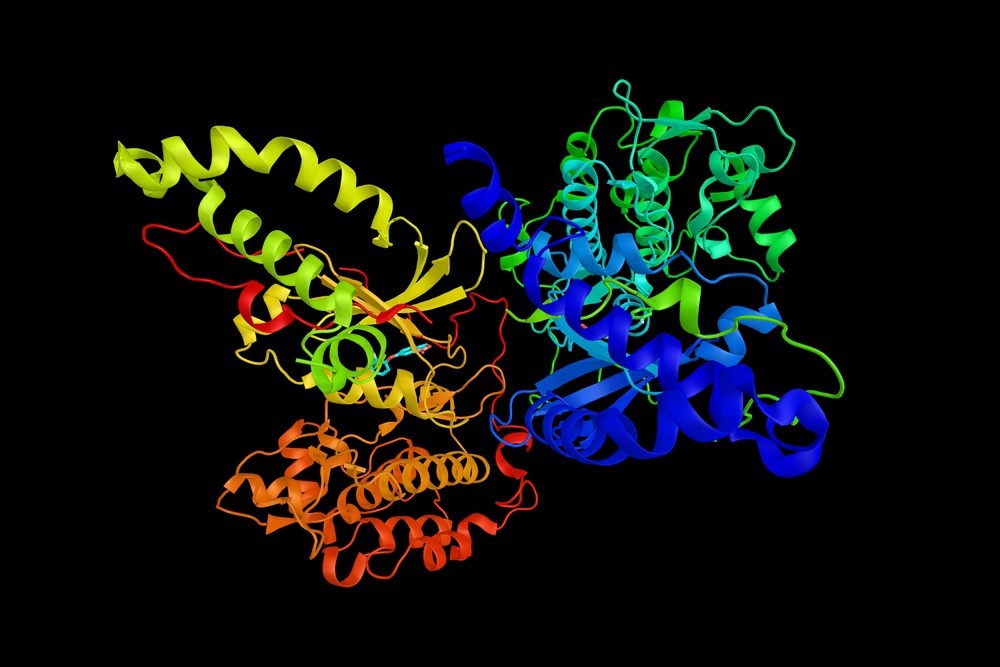Scientists have developed an in-cell protein crystallization method to understand the structure and function relationship of protein crystals. Utilizing in-cell protein crystallization in structural biology has significantly contributed to progress in the field and has prevented the need for protein purification and crystallization steps.

Study: Cell-free protein crystallization for nanocrystal structure determination. Image Credit: ibreakstock/Shutterstock.com
Protein crystals are formed inadvertently in live cells and lack adequate size or quality for structural investigations, resulting in the in-cell protein crystallization approach being restricted to only a few proteins. An article published in Scientific Reports presented a cell-free technique for the direct crystallization of proteins without the need for a living cell.
Here, the nano-sized polyhedra crystal (PhC) was prepared via cell-free protein synthesis, and its structure was determined using the X-ray diffraction (XRD) technique at a high resolution of 1.80 angstroms. Furthermore, nanocrystals were created using the dialysis method at a reaction scale of 20 microliters, followed by analyzing its structure at a resolution of 1.95 angstroms.
Additionally, structural analysis of crystalline inclusion protein A (CipA), a bacterial in-cell crystal, via cell-free protein crystallization helped validate the technique's potential. Chemical reagents were added to the cell-free protein crystallization solution as twinning inhibitors, enabling the structural determination of CipA at a resolution of 2.11 angstroms.
In-Cell Versus Cell-Free Protein Synthesis
Recently, there have been numerous reports on protein crystallization in live cells. Such crystals facilitate biological functions, including heterogeneous catalysis, protein storage, and immune system activation.
Since the discovery of the polyhedral structure in 2007, the relationship between the structures and functions of crystals has been examined by precise structural analysis of micron-sized crystals generated in live cells.
In-cell protein crystallization skips purification processes and extensive large-scale crystallization screening to create high-quality crystals. Hence, this crystallization technique is anticipated to be the next-generation tool in structural biology.
Several in-cell protein crystallization techniques, including cell culture optimization and high throughput screening, have been developed to address the issues with protein structure analysis. Within this framework, LaBaer et al. successfully created microcrystals by building a series of baculovirus expression vectors for large-scale protein production in insect cells. Currently employed insect and mammalian cells for in-cell protein crystallization continue to pose a considerable hindrance to producing vast quantities of high-quality microcrystals.
In this regard, a cell-free protein synthesis system is a simple, rapid, and sensitive tool devoid of membrane-bound barriers yet contains all the mandatory substrates and biomolecules required for synthesizing the desired proteins.
Cell-free protein synthesis has the potential to overcome loopholes in the current in vivo production systems and is a promising tool in both fundamental and applied scientific research. However, cell-free protein synthesis has been deemed inadequate for structural biology processes, such as crystallization, because it requires high amounts of protein.
In-Cell Versus Cell-Free Protein Crystallization of PhC and CipA
Previous reports have mentioned that the complex structures of living cells influence the in-cell protein crystallization of PhC and CipA. Moreover, the crystallization of CipA via the in-cell protein crystallization method resulted in twin crystals, making it difficult to determine its crystal structure.
In this regard, the cell-free protein crystallization facilitated the formation of protein crystals from a small reaction volume of 20 microliters. Thus, cell-free protein crystallization allowed the PhC formation 6 hours after initiating the reaction and was analyzed at a resolution of 2.50 angstroms using XRD.
In contrast, in-cell protein crystallization required three days to fetch PhCs synthesized in insect cells (PhC_IC) after viral infection because insect cells undergo various cellular processes to produce the target protein. This variation suggests that cell-free protein crystallization can resolve the problem of low-yield and high-quality protein crystals associated with in-cell protein crystallization.
The crystal structure of CipA was obtained at high resolution using XRD by adding a chemical reagent (1,4-dioxane) to inhibit twinning in the cell-free protein crystallization reaction mixture. CipA crystals obtained via cell-free protein crystallization (CipAC_CF) formed a multilayer structure composed of tetramers as building blocks.
Conclusion
In summary, a cell-free protein synthesis method was established to analyze protein crystals in microliter volumes and in a short time without the need for purification and crystallization processes.
The determination of the nanocrystal structure revealed high-resolution structures of the proteins. Despite the anticipation by researchers that in-cell protein crystallization could be a crucial tool in analyzing the nanocrystal structures, the difficulty in achieving adequate quality and quantity of crystals restricted its use.
Alternatively, the cell-free protein synthesis established in this study enabled the quick screening of reaction conditions and the impact of additives on reactions and helped realize high-quality protein crystals for nanocrystal structure determination.
The research findings indicated that cell-free protein synthesis could be a powerful tool for nanocrystal structure determination of unstable or low-yielding proteins, whose crystallization is challenging via traditional in-cell protein crystallization methods.
Reference
Abe, S et al. (2022). Cell-free protein crystallization for nanocrystal structure determination. Scientific Reports. https://www.nature.com/articles/s41598-022-19681-9#Abs1
Disclaimer: The views expressed here are those of the author expressed in their private capacity and do not necessarily represent the views of AZoM.com Limited T/A AZoNetwork the owner and operator of this website. This disclaimer forms part of the Terms and conditions of use of this website.